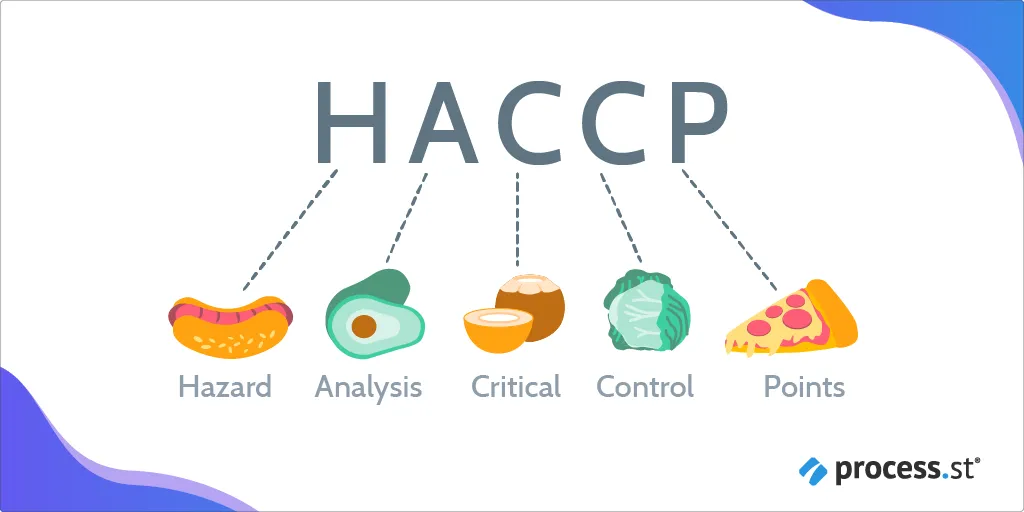HACCP Plan: What It Is, Why It’s Important, & How to Do It (Free Templates)
Blog: The Process Street Blog

Growing up on an island, my favorite food was in abundance: Fish.
However, whenever I ate at a restaurant there was always a voice in the back of my head wondering if the fish had been mismanaged and, due to that mismanagement, I’d get sick.
My anxiety around food safety wasn’t exactly unfounded. Fish is the most commonly impacted food group when it comes to disease outbreaks, and a quarter of a million people in the U.S. get sick each year from contaminated fish. And when it comes to all food groups, the CDC estimates that a whopping 1 in 6 Americans (which equates to 48 million people) become ill each year due to foodborne illness.
However, by not coming at food safety with a HACCP approach – and by creating and following a solid HACCP plan – these figures could be far, far higher.
Ergo: HACCP is important and, as a business in the food industry, you can even be required by law to go about HACCP properly.
To help you out, in this post I’ll discuss what HACCP and a HACCP plan are in detail, HACCP’s history, the benefits, and how Process Street can help you with all-things HACCP and food safety.
Just read through the following sections:
- What is HACCP (and what is a HACCP plan)?
- The incredible history of HACCP
- The benefits of HACCP (and having a HACCP plan)
- Use Process Street for all-things HACCP!
Let’s swim through the rest of the post! 
What is HACCP (and what is a HACCP plan)?

The acronym HACCP stands for Hazard Analysis (and) Critical Control Points.
It’s an approach to food safety, attempting to minimize food risk as much as possible by analyzing and controlling biological, chemical, and physical hazards. This approach concerns raw material production (for seafood, this is capturing the fish) all the way until the product’s consumption (i.e. when somebody eats the fish).
When it comes down to the nitty-gritty, the HACCP principles, as outlined by Nebraska’s Institute of Agricultural and Natural Resources, include:
- Conducting a hazard analysis
- Identifying the Critical Control Points (CCP)
- Establishing critical limits
- Monitoring CCP
- Establishing corrective action
- Verification
- Record-keeping
If you’ve read Process Street’s posts on FSSC 22000, FSSC 22000 compliance, and ISO 22000, you may be wondering where, exactly, HACCP fits into everything. Is it a part of a food safety management system? Is it a food safety management system in itself? Where does HACCP begin and end?
To avoid confusion, it’s best to think of HACCP as a food safety approach. While it’s technically a small food safety management system in itself, HACCP can also be a part of a larger food safety management system such as ISO 22000.
HACCP is necessary for processing most foods. The FDA requires businesses to use the HACCP approach for seafood and juice processing, while the USDA requires HACCP for meat and poultry, and the Food Safety Modernization Act requires a food safety plan for, well, everything else!
Now that you’ve understood what HACCP is in more detail, it’s time to turn your attention to the HACCP plan.
What is a HACCP plan?
While HACCP is an approach, a HACCP plan (sometimes referred to as a HACCP process document) informs people of the necessary food safety-related procedures that should be followed to manage food safety hazards. Essentially, a HACCP plan is needed to go about HACCP in the right way.
Speaking of which, here’s a free HACCP Plan process made by us here at Process Street.
Click here to get the HACCP Process!
The incredible history of HACCP
What’s HACCP got to do with space?
A lot.
In the 1950s, the team of National Aeronautics and Space Administration (otherwise known as NASA), the Pillsbury Company, and the Natick Research Laboratories came together to work on a project.
The project was to build an approach to minimizing food risk, as they wanted to ensure food safety for their astronauts who were going out into space. (Because the last thing you want to do while floating about in the universe is to eat bad chicken space paste, throw up, and… well, I’ll let you imagine the visuals of cleaning up the mess.)
Roughly two decades later, the HACCP concept was shown at the National Conference on Food Protection, which was backed by the United States’ premier food safety and food regulation organizations – the Food and Drug Administration (FDA) and the American Public Health Association (APHA). It was a big hit.
Why?
Good question.
First off, let’s talk about CCP – Critical Control Points. A Critical Control Point, technically speaking, is where people (usually consumers) could be harmed or put in danger due to the failure of a Standard Operating Procedure (SOP).
For reference, the below Process Street template helps guide businesses with creating their very own SOPs from scratch. (Process Street in itself is nifty SOP software!)
Click here to get the Standard Operating Procedure (SOP) Template Structure Template!
NASA had previously been using CCP as part of their engineering management requirements, as to test the reliability of their engineering systems. With this in mind, looking at and overcoming Critical Control Point issues was – and still is – deemed as a solid and robust way of ensuring quality, especially considering its use by NASA. Thinking back to CCP in a food context, and also bringing in Hazard Analysis, it’s no wonder why HACCP has been lauded so, and has become an integral part of the modern world’s food safety standards.
HACCP is, in fact, so good at stopping quality and safety issues from occurring that it’s not only used in the contemporary food industry, but also pharmaceuticals and makeup.
The takeaway here is that HACCP has been around for a long time and was developed by some of the best, most forward-thinking organizations on Earth. Considering it’s been used for this long, it’s safe to say that HACCP is here to stay.
It’s high time you started using the HACCP approach (or if you already are, then doing it in a better, more optimized way).
The benefits of HACCP (and having a HACCP plan)
Need further persuading that you should use and follow HACCP? Not convinced of the need for a HACCP plan?
If so, I’m presuming the above text about NASA and HACCP didn’t convince you.
But the list of benefits below surely will.
Specifically, the benefits of HACCP include:
- Not poisoning your customers.

- Complying with the law.

- Showing the rest of the world you mean business.

- Taking control of your food-related processes.

For businesses in the food sector, not poisoning your customers is, well, pretty up there when it comes to benefits. Especially as food contamination can lead to your brand’s reputation nose-diving, the potential for being sued by the person who got sick or by the loved ones of the person who got sick, and encourages other companies, brands, and suppliers to work with you on a long-term basis. Considering the earlier statistic – that 1 in 6 Americans fall ill due to food contamination each year – not enough food risks are quashed. But by going about HACCP properly, precisely, and professionally, you’re able to lower the risks in your products.
For businesses in the U.S., HACCP is a legal requirement established by organizations such as the FDA. But just because it’s a legal requirement, that doesn’t mean businesses do actually follow HACCP properly or even establish a HACCP plan in the first place. Don’t be like them. Be compliant.
HACCP is an internationally-recognized approach to food safety. Let’s say you’re wanting to start trading in Germany. Considering the fastidious bureaucracy Germany is known for, you want to promote yourself as trustworthy, serious, and professional to the Germans (and any other country, too). Being able to say that you use the HACCP approach to food safety will go a long way when it comes to international trading.
At its core, HACCP is all about minimizing food risk. Invariably, this means ensuring your food-related processes and procedures aren’t just up to scratch, but they’re the best they can be. So by using the HACCP approach – and having a HACCP plan to help guide you and the rest of your team – you’re able to take full control of your relevant food processes in a way you’ve never done before.
This is a pretty impressive list of benefits, right?
Luckily for you, reader, the good news doesn’t end there: Prepare to have your mind blown out of this world.
Process Street, which is a powerful piece of BPM software, allows you to go about HACCP – and food safety management in general – incredibly easily.
Use Process Street for all-things HACCP and food safety!
Process Street is superpowered checklists.
If you document workflows, business processes, and integral procedures as templates, you can then launch an infinite number of checklists from those templates. Checklists help you complete recurring tasks and processes efficiently and effectively.
For a visual introduction to Process Street, watch the video below.
Now, when it comes to food safety, you’re able to use Process Street to document business processes and procedures relevant to your food safety management system, be it FSSC 22000 or ISO 22000. Then, you can launch checklists to help you undergo those processes correctly.
But when it comes to HACCP in particular, you hardly have to lift a finger.
We’ve got a HACCP Process template (aka a HACCP plan) and a HACCP Compliance Checklist!
In terms of the HACCP Process template, you’ll:
- Plan what needs to be done and write this down.
- Do what you planned to do to maintain food safety.
- Check that you are doing what you planned to do to maintain food safety and write down what was checked and when.
- Act to correct any food safety problems and write down what has been done about the problem and when.
Just sign up for free and add it to your account.
Click here to get the HACCP Process!
As for the HACCP Compliance Checklist, this is an internal audit checklist that’ll help you evaluate compliance with HACCP requirements. It covers:
- Hazard analysis
- Critical control points
- Monitoring procedures
- Corrective action
- Verification procedures
- Cleaning procedures
- Pest control
- Training
Ready to add this template to your account, too?
Click here to get the HACCP Compliance Checklist!
These checklist templates are superpowered thanks to Process Street’s workflow automation features.
These include (but aren’t limited to):
- Stop tasks

- Dynamic due dates

- Conditional logic

- Task permissions

- Task assignments

- Role assignments

- Webhooks

- Embed widget

- Approvals

It’s superpowered business process management software without the killer price tag!
To deep dive into some of these features further, watch the following webinar.
So, reader. I think you’ve got enough free templates to get firmly acquainted with HACCP.
But don’t forget: With your new, shiny Process Street account, you can create checklist templates for all your processes, HACCP-related or not!
Here’s to not being a fish out of water and going about food safety like a pro.
Are you a HACCP maestro? If so, are there any tips and tricks you’d like to share with the Process Street community? Write them in the comment section below. 


